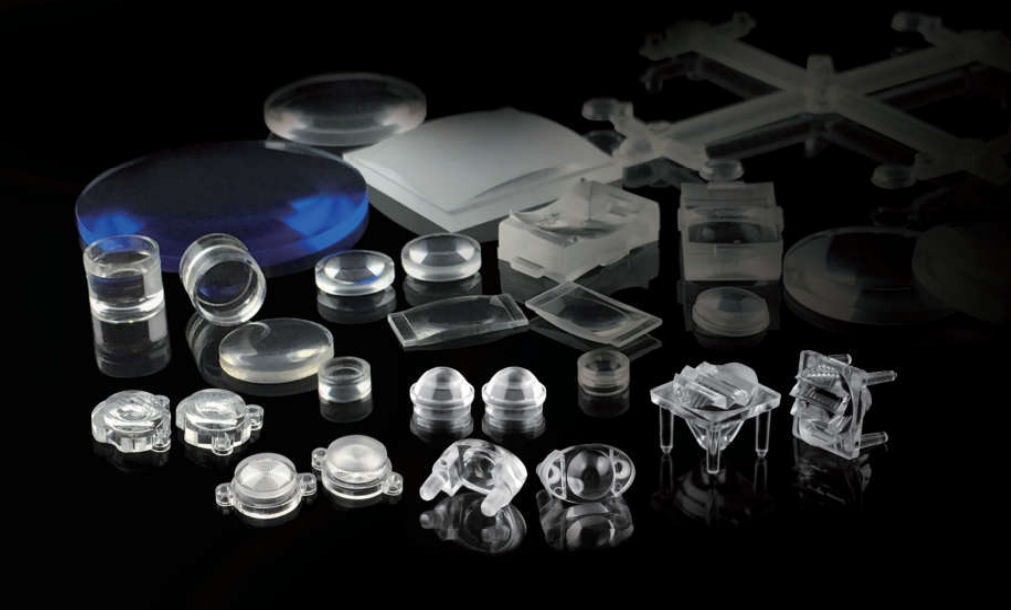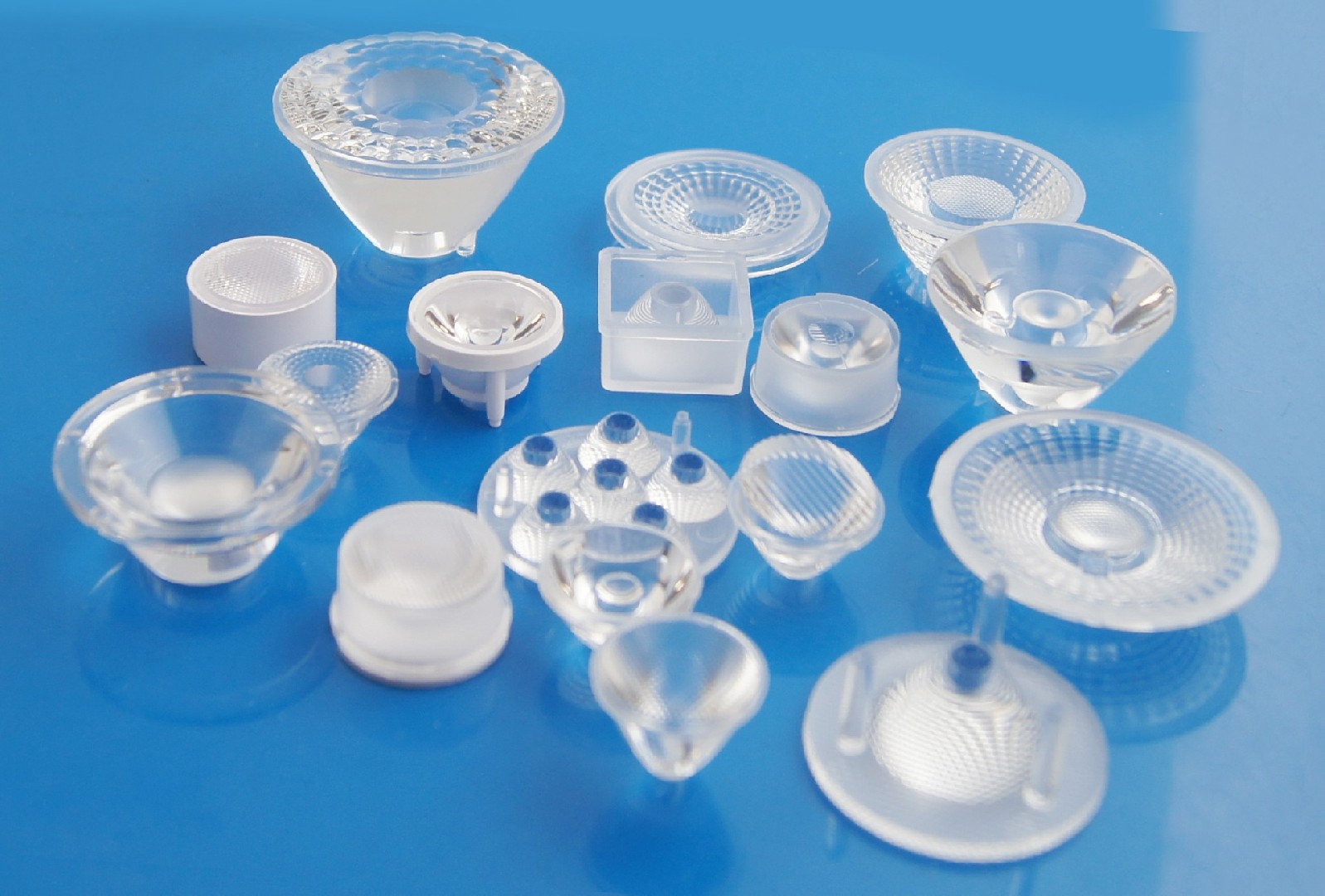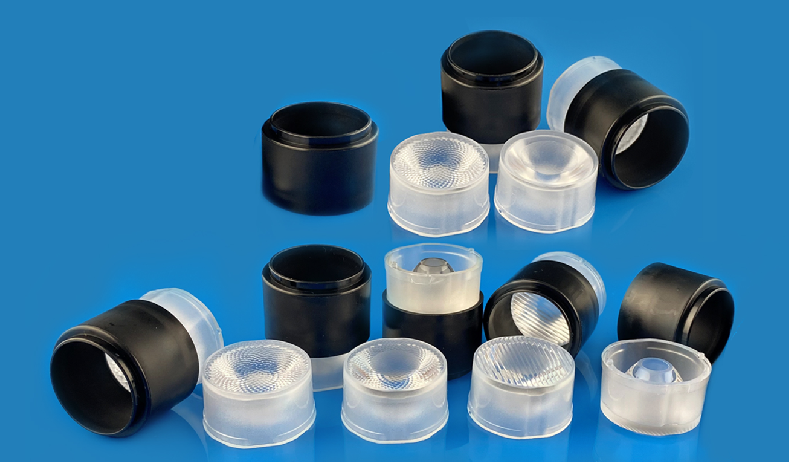
The most classic of standard lenses is the conical lens. These lenses rely heavily on Total Internal Reflection (TIR), so they are called TIR (Total Internal Reflection) lenses. Usually TIR lenses are axisymmetric in design to provide a nice round spot, and can be combined with multiple LEDs to form an array lens or a single lens with a bracket for easy installation and light control.
TIR Lens VS Reflector
In fact, both of them have the same basic working principle, but TIR lens has more control, because every ray of TIR lens is controlled and utilised, while a large part of the light of reflector is not in contact with the reflective surface without control, this is easy to see in small angle optics, the light pattern of reflector is not as sharp as that of TIR lens (in short, the secondary spot of reflector is bigger). The light pattern of the reflector is not as sharp as the light pattern of the TIR lens (in short, the secondary spot of the reflector is bigger).
Different optical properties use different TIR lenses, and the size of the lens and the LEDs directly affect the optical properties, so it is inaccurate to talk about the angle, light intensity and efficiency without clear prerequisites, a good optical design must be perfectly coordinated with the light distribution of the LEDs in order to get a good optical effect. In professional optical design, there is no one-size-fits-all product, but rather, there is a targeted optical match and targeted application.
In the following, we will analyse the different optics in the TIR lens family:
Real Spot Lens (-RS)
In the lens family, this type of lens is the most concentrating lens, the purpose is to obtain a high cd/lm (peak light intensity) but also leads to the lack of part of the light mixing performance, this type of lens is easy to identify, generally is the surface of the crystal through and through, part of it may also be hollow. The main direction of the application of this type of lens includes: floodlights, spotlights, long-distance wall washer lamps, and so on. Cases such as bridge lighting, high-rise building lighting, indoor spotlights and so on.
Soft Spot Lens - SS
The biggest difference between this type of lens and the spotlight lens is that the surface has been softened to achieve a better distribution of light quality, but compared to the front of the spotlight lens its cd/lm will be relatively low, and the angle will be slightly wider. Here the application of optics is also mainly cast light, spotlights, etc.. There is no one who is good and who is bad, are to meet the needs of different light applications, the fish and the bear's paw are good things, just different application direction.
Diffusion Concentration Lens (-D-)
This type of lens has a diffusion surface design in the three concentrator lens light distribution is the smoothest, compared to the cd / lm achieved peak light intensity than with a soft surface design lens is slightly lower, but the angle of the two is about the same. Because of its surface is diffusion surface treatment, light mixing effect will be better, compared to the glare control effect will be better, so the application of this wall washer light and the mid-range distance of the floodlight, spotlight effect is a bar.
Medium Angle Lens (-M/M2)
The light distribution effect of this type of lens between the spotlight lens and large angle lens, the surface has a small "pillow" surface design, if you put an LED inside looks a little like some kind of "flying insect eyes", generally speaking, there will be no rough diffuse reflection. Surface. Widely used in a wide variety of lamps and luminaires for even light distribution.
Elliptical Lenses (-O/ -O-90)
This type of lens is most widely used in architectural wall washer lights, advertising light box lighting, etc.. The elliptical light distribution is expressed as a certain axial light distribution is very wide, while the other axis is a small light angle. The purpose is very simple, the light type represents everything, wide is to C0-C180 ° light distribution coverage of wide and uniform, narrow axial C90-C270 ° light distribution is to spread the light farther. These lenses are also available in a version with its own deflection angle to facilitate wall washer applications where the fixture cannot be adjusted.
Large Angle Lenses (-W-W4)
This type of lens belongs to the TIR family of lenses in the large angle category, from 40 ° to 80 ° in the middle of the subdivided into a number of angle grades, the larger the angle means that the wider the light distribution. These lenses generally have a rough diffuse reflective surface as standard, but some may have a medium sized "pillow" surface or a curved surface, or both. These lenses are used in a wide variety of applications.
Last Article:Role of Optical Filters
Next Article:Taking stock of optics in the Nobel Prize: making a difference to human society


